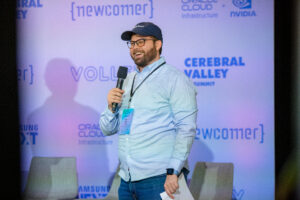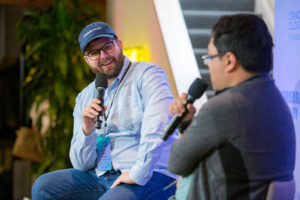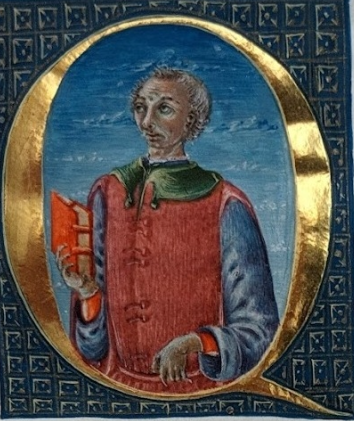The Influencer Journalist, Eric Newcomer

Four years ago Eric Newcomer derailed a classic journalism career of bigger outlets and bigger beats so he could make news for a changing world. “Make news” in both the sense of turning out journalism on his chosen beat of tech startups and the venture capitalists that back them, and making news by hosting events where deals happen and partnerships are struck. He sees himself as an influencer within the Artificial Intelligence startup ecosystem, both reporting and participating. It’s a new turn for the industry, he says, and it feels like it’s here to stay.
Eric Newcomer: I started out with a Substack newsletter. Now it’s a newsletter and events business, which took off surprisingly quickly. I host events, the Cerebral Valley AI Summit that was held in New York in June, following a couple of events in San Francisco. We’ll have another San Francisco version in November. We did a banking Summit in New York in March, too. The newsletter is still key in many ways, for the brand, and the revenue stream, helping me and another reporter, Madeline Renbarger, stay on top of things.
I started four years ago, and now I have a staff of five, including part timers. I told Axios I crossed $1 million in revenue last year.
Quentin Hardy: Aside from that big number, how different is this from being a traditional reporter, or just running a newsletter?
EN: Different. If I wasn’t born with journalism in my blood, it was pretty close. I was an anchor on my Elementary School newscast, and was one of the last people to come up this sort of normal reporter path: Harvard Crimson, The Sun Sentinel, The Tampa Bay Times, The New York Times internship…Jessica Lessin found me through the Crimson network and I joined The Information early. Jumped ship to Bloomberg, where I stayed six years, mostly in San Francisco doing tech.
QH: That’s the dream. You could have done that to retirement.
EN: Maybe it was the dream, but things have changed. My last year at Bloomberg I started covering disinformation, which was my idea, and I helped them start their tech newsletter. But after a while I wasn’t that excited about it. It wasn’t solving my problem.
QH: Which was?
EN: What they called “news analysis’ were opinions that were safe to hold at Bloomberg. Like a lot of traditional media, they were hung up on the “view from nowhere” style of supposed impartiality, and felt like they had to explain every little thing. I wanted to write for my audience, I didn’t want to have to explain for every reader who Bill Gurley and Marc Andreessen were.
QH: When I was coming up at The Wall Street Journal they’d tell you to write everything so a grandmother in Iowa could understand it. So every time someone mentioned short selling in the stock market, there’d be a little explanation of what short selling is. It did feel a little weird, if you were writing about the nuances of capital formation in Japan – what was the grandma doing reading that, unless she ran a hedge fund?
Anyway, it sounds like you wanted to be closer to a specific audience, almost one of them, more than you wanted to be a supposedly neutral journalist.
EN: That’s something I should address head on. What’s this series called, “Life After Journalism”? In some important ways I’m a journalist. I value that. But I would rather be a news influencer who exceeds expectations than constantly face the challenge of being a journalist who has to live up to an impossible standard. I cherish my reputation like journalists do, in getting a story right, getting the facts in front of people. But I’d rather be a really well trusted influencer than to hold on to the journalism brand, which lately has come to have a lot of baggage in Silicon Valley and other places.
QH: So going back to how you started, how’d you start?
EN: I’d been covering startups, and Substack shows up. It’s a platform for publishing and charging for newsletters, so it’s something to do with me. I could react to this new thing by getting directly involved with it.
QH: This was September 2020, during the Covid lockdown. It’s a leap any time. How hard was that?
EN: My now wife and friends were very supportive. Surrounding yourself with Silicon Valley types makes it a little bit easier to quit your job to start something new. A lot of them have done it. like a lot of your friends have done the same thing.
Still, the day I had to tell my editors I was leaving Bloomberg I chickened out on the first call. My wife told me to do it, really supported me. It was definitely terrifying, but thrilling. During Covid the call of the office didn’t exist, and Silicon Valley people were scattered, so that probably helped that someone was writing about people they knew, but weren’t seeing. I was fortunate that Bill Gurley gave me an interview really early. Dara Khosrowshahi at Uber gave me an interview by the time I put up the paywall, a couple months after starting. It started to feel like it was going to work. By September 2022 I hired my first employee.
QH: How did you get into the events business?
EN: Maybe I was thinking it would be valuable to create a neutral ground where all these venture firms and all these startups, particularly around AI, could be together in person, post-Covid. The reality is, we fell backwards into it. I’m based in Brooklyn, but I was going to my bachelor party outside of San Francisco, and I figured I should make it a business trip so I could expense my flights. I had some friends with empty space in Hayes Valley in San Francisco, so I started texting people. Within 30 minutes I heard from Miles Grimshaw who was at Benchmark, and Bucky Moore who’s at Kleiner Perkins and, importantly, Emad Mostaque at Stability AI.
Almost instantly, it felt like it could be big, with so much appetite for this. It turned into this whole day event that I hosted, with admission, and featured speakers. Two people talked at the speaker dinner, and that turned into a billion-dollar corporate acquisition, which Fortune wrote about.
After that, we decided to do a more formal all-day event, at a bigger venue, with sponsorships, and the right audience mix. The goal is 50% startups, company founders, which are the core of the network of people you want to meet in AI. Then investors, corporates, and a little and top press. The event is complimented by newsletter coverage, YouTube videos, and press coverage to reach a broader audience. People come because they meet exciting people who are involved in building out AI, what we call Cerebral Valley.
 QH: And a business is born. Earlier in this conversation you described yourself as an influencer. What did you mean by that?
QH: And a business is born. Earlier in this conversation you described yourself as an influencer. What did you mean by that?
EN: I’m writing to people inside an industry about what’s going on around them, and I’m giving them an environment where they can do business. That’s different from being a “view from nowhere” journalist. I’m still on Substack, and publishing a significant amount. A lot of the time i’m finding out what’s news through my customers, which feels very symbiotic, writing stuff that people are interested in and participating in it through the Substack and the conferences. It’s niche, but it’s very “of the moment.”
QH: Since an influencer is also of the community, can an influencer be critical?
EN: The first order principle is building a product that my customers want, not what is my divine sense of what a great story is, disconnected from the customer. I do feel aligned with building a business for a customer who is smart and wants fair and good journalism and well-reported stories. Big news organizations can be very detached from the customer. At Bloomberg I was much more oriented towards what my editor wanted.
All that said, can I be critical? Definitely. I’ve been on “This Week In Startups” with Jason Calacanis, who also has a show with Chamath Palihapitiya, and I’ve also written two of the most negative pieces on Chamath. Sam Altman came to my speaker dinner last November, but when the OpenAI board kicked him out as CEO I wrote what I’d say was the strongest defense of the board. That’s one of the most important people in AI, while I’m organizing AI conferences. Ninety percent of my audience wants me to be honest about what I’m thinking, no matter what.
QH: Do you think there will be journalism influencers like you in other industries?
EN: There are already. The Ankler, in Hollywood, is ahead of me. He’s almost crankier than I am on a lot of things, really annoying the industry, and that site is selling Oscar ads. That’s a good example. Then there’s Punchbowl, which is all about Washington, which has a bigger team and went out with venture money. Those publications feel like they’re committed to really getting at the truth of their worlds.
QH: Do think having some of the most knowledgeable people going hyperspecialized will be bad for general interest newsreaders?
EN: There are definitely a lot of former beat reporters writing for their niches, of all kinds. ANd specialists, who maybe never were reporters. There’s a guy named Levy Rozman who runs a YouTube channel called Gotham Chess. I get chess news from him, but he also does explainers. He’s basically a reporter. Maybe it is becoming a highly specialized world.
QH: Does what you’re doing feel like a stable, long-term business?
EN: It would be harder if I was a solo writer. That was lonely. At first it wasn’t bad, because I had all these ideas, particularly stuff I couldn’t write about at Bloomberg. And coming out of the gate I was hungry. The second year to me was the hardest; all the new ideas were gone, and I really had to work on the content pipeline. At a place like Bloomberg if I didn’t write for a couple weeks, no big deal, nobody would notice. It was very frustrating to be doing productive stuff like making important connections, but then not having written. It could feel like I was failing on the main thing. Now, building more of a newsroom to support the overall production, it feels very sustainable. I’m excited about continuing to make more money with events and then finding ways to use that money well, like hiring another great reporter.
QH: In my experience at the Journal and Forbes, events is pretty recession sensitive. Things can be going great, and within a couple of weeks it’s a grease spot. Is that a concern?
EN: Being a connector for people in startups and venture capital means I’ve got a fairly wealthy audience doing something that’s of national importance. People want to know about people who are building stuff that will change the future. I’ve built this out cautiously, with just me and two full-time employees. I can get jealous of the Pucks and Semafors, the newsletters that raised a lot of venture money, which gets you attention. But so far every event we’ve done has made money, we’re not building up big to get profitable in three years.
Besides, These are events with 150-300 people, it’s not like we’re bringing 10,000 people to a hotel we’ve rented in Vegas. I can see a world where a recession would hit us like everyone else, but that would only be for a specific event, and then we’d adjust course.
QH: You’re happy with this size of empire.
EN: Oh, I’m super hungry and ambitious. I’m just hungry and ambitious within this world of startups and venture capital. I feel like there’s plenty to do in this world of business and tech. I’m not trying to build the next Wall Street Journal. Maybe just the next Pitchbook.
QH: Do you miss the old world?
EN: I text journalists all the time. They’re my friends, and I think they would still consider me a journalist. Newsrooms are nice, and it’s fun to be able to gossip about stuff. But I’m building the newsroom myself. I’m very happy with my decision to build my own organization. The stories I’m writing feel much truer. I’m writing what I’m thinking about, in the service of channeling what my sources are saying, but also with my own direct passion. It results in work that I feel more strongly about. Plus, I’m managing a reporter, finding stories, prioritizing, hiring a podcast producer, finding speakers for a conference, thinking and dreaming about the future. Building a business gives me a lot of empathy for my readers.


